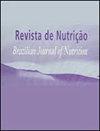covid -19后综合征患者面临营养不良和肥胖的风险:门诊随访结果
IF 0.5
4区 医学
Q4 NUTRITION & DIETETICS
Revista De Nutricao-brazilian Journal of Nutrition
Pub Date : 2022-01-01
DOI:10.1590/1678-9865202235e220015
引用次数: 0
摘要
【摘要】目的通过阑尾骨骼肌质量指数(appendar Skeletal Muscle Mass Index)分层,评估covid -19综合征后患者的营养和功能状况、吞咽障碍和肌肉骨骼表现。方法对某大学附属医院重症监护病房出院后诊断为covid -19后综合征的患者进行横断面研究。评估的结果包括:营养状况(迷你营养评估、生物阻抗和人体测量)、吞咽障碍(吞咽困难风险评估方案)、功能状态(covid -19后功能状态量表)和肌肉骨骼表现。根据阑尾骨骼肌质量指数,根据肌肉质量的减少或不减少对患者进行分层。结果38例患者纳入研究,其中20例分为肌肉量未减少组(女性17例;49.45±12.67岁),18例为肌肉量减少组(男性18例;61.89±12.49年)。两组都有营养不良的风险(迷你营养评估得分在17-23.5分之间;肌肉量未减少组:21.82±3.93;肌肉量减少组:23.33±3.41)和肥胖组(肌肉量未减少组:33.76±6.34;肌肉量损失组:30.23±3.66)。两组在生物阻抗参数(脂肪量除外)和年龄方面存在差异。然而,在吞咽改变、功能状态和肌肉骨骼表现方面没有差异。结论根据阑尾骨骼肌质量指数分层的新冠肺炎后综合征患者存在营养不良和肥胖的风险。值得注意的是,出院后6个月持续出现疲劳、虚弱、肌痛和关节痛。这些发现强调了对covid -19后综合征患者进行全面护理的重要性。本文章由计算机程序翻译,如有差异,请以英文原文为准。
Patients with Post-Covid-19 Syndrome are at risk of malnutrition and obesity: findings of outpatient follow-up
ABSTRACT Objective To evaluate the nutritional and functional status, swallowing disorders, and musculoskeletal manifestations of patients with Post-Covid-19 Syndrome, stratified by the Appendicular Skeletal Muscle Mass Index. Methods This is a cross-sectional study with patients diagnosed with Post-Covid-19 Syndrome after discharge from the intensive care unit of a university hospital. The evaluated outcomes were: nutritional status (Mini Nutritional Assessment, bioimpedance and anthropometry), swallowing disorders (Dysphagia Risk Evaluation Protocol), functional status (Post-Covid-19 Functional Status Scale), and musculoskeletal manifestations. According to the Appendicular Skeletal Muscle Mass Index, patients were stratified in terms of loss or not loss of muscle mass. Results Thirty-eight patients were included in the study, 20 stratified into the no loss of muscle mass group (17 females; 49.45±12.67 years) and 18 into the loss of muscle mass group (18 males; 61.89±12.49 years). Both groups were at risk of malnutrition (Mini Nutritional Assessment scores between 17–23.5 points; No Loss of Muscle Mass Group: 21.82±3.93; Loss of Muscle Mass Group: 23.33±3.41) and obesity (No Loss of Muscle Mass Group: 33.76±6.34; Loss of Muscle Mass Group: 30.23±3.66). The groups differed in terms of bioimpedance parameters (except fat mass) and age. However, there were no differences in swallowing alterations, functional status, and musculoskeletal manifestations. Conclusion Patients with Post-Covid-19 Syndrome, stratified according to the Appendicular Skeletal Muscle Mass Index, were at risk of malnutrition and obesity. The persistence of fatigue, weakness, myalgia and arthralgia at 6 months after hospital discharge is noteworthy. These findings emphasize the importance of comprehensive care for patients with Post-Covid-19 Syndrome.
求助全文
通过发布文献求助,成功后即可免费获取论文全文。
去求助
来源期刊
CiteScore
1.20
自引率
12.50%
发文量
24
审稿时长
6-12 weeks
期刊介绍:
Revista de Nutrição is former Revista de Nutrição da Puccamp, founded in 1988. It is a bimonthly publication every four months and it is of responsibility of the Centro de Ciências da Vida, da Pontifícia Universidade Católica de Campinas . It publishes articles that contribute to the study of Nutrition in its many sub-areas and interfaces; and is open to contributions of the national and international scientific communities.

 求助内容:
求助内容: 应助结果提醒方式:
应助结果提醒方式:


